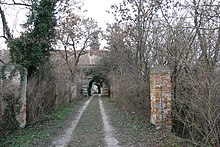Rabensburg Castle
| Rabensburg Castle | ||
|---|---|---|
| Place: | Rabensburg, Austria |
|
| Geographical location | 48 ° 39 '1.4 " N , 16 ° 54' 10.6" E | |
| Height: | 167 m above sea level A. | |
|
|
||
The Rabensburg Castle is a castle in the same community Rabensburg in Lower Austria .
history
The original Rabensburg is said to have fallen into the possession of the Regensburg burgrave Burkhard in 1045, when the area belonged to the Hungarian Mark . The then wooden castle was probably built in stone around 1200.
In 1255, Hertwicus de Rebensburch , a follower of the Kuenringer at the same time as the town of Rabensburg, appears for the first time in a document. At that time the castle was a moated castle . In 1294 Otto II von Hagenberg acquired the rule of Rabensburg, which was then conquered by King John of Bohemia in 1328 . During the 14th century it came into the possession of Zelkinger , but was already in 1385 by Hans and Ulrich von Zelking to John II. Of Liechtenstein resold. Around 25 villages in the area belonged to the rule at that time.
In the years 1540 to 1550 the castle was rebuilt on a large scale by Georg Hartmann von Liechtenstein. The outer facades were decorated with paintings and sgraffitis under Johann Septimus von Liechtenstein towards the end of the 16th century . For Maximilian von Liechtenstein , the brother of Charles , the founder of the Princely House of Liechtenstein, the castle became the main residence. Under him, the complex was significantly expanded and converted into a castle. Even bastions that were equipped with guns, were built under it. Nevertheless, the castle was captured by the Swedish general Lennart Torstensson in 1645 during the Thirty Years War and the neighboring church was also destroyed. However, the castle was again taken into possession by the Liechtensteiners the following year.
The Kuruc invasions in 1704 and 1706 caused renewed devastation , so that the services had to be held in the knight's hall until 1765 .
The Liechtensteiners kept the castle with an interruption until 1991. After Maximilian, however, it was no longer inhabited by the rulers and only served as an estate management and official residence. After the sale in 1861, a parquet flooring factory was also housed in the building. During this time, valuable frescoes and building fabric were lost. However, after a few years it was bought back by the Liechtensteiners.
In 1991 the gravel pit owner Günther Kucharovits bought the castle complex, which is now inhabited by some tenants. Since the building was not renovated, it looks neglected from the outside.
literature
- Dehio - Lower Austria north of the Danube. 1990.
- The castles and palaces of Lower Austria. Volume 2. 1925.
- Hellmut Bornemann: Land on the Thaya. 2001.
- Rudolf Büttner: Castles and palaces from Marchfeld to Falkenstein. 1982.
- Kollar Daniel: Austrian-Slovak Marchland. 1996.
- Franz Eppel: Art in the country around Vienna. 1977.
- Thomas Hofmann: The Weinviertel and Marchfeld. 2000.
- Manfred Jasser, Peter Kenyeres: Palaces and castles in the Weinviertel. 1979.
- Georg Clam Martinic: Austrian Castle Lexicon. 1992.
- Gerhard Stenzel: From castle to castle in Austria. 1976.
- Thomas Winkelbauer: Prince and Prince Servant: Gundaker von Liechtenstein, an Austrian aristocrat of the denominational age. 1999, ISBN 3-486-64837-3 .
Web links
- Entry about Rabensburg Castle on Lower Austria Castles online - Institute for Reality Studies of the Middle Ages and Early Modern Times, University of Salzburg
- Entry via Rabensburg Castle to Burgen-Austria
- Rabensburg Castle on the website of the municipality




